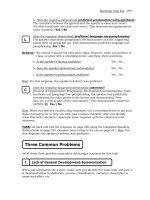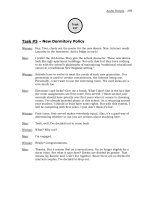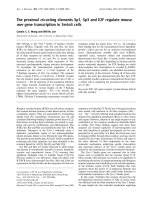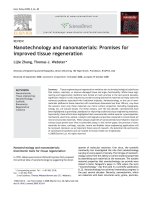Bio nanoparticles and bio microfibers for improved gene transfer into glioma cells
Bạn đang xem bản rút gọn của tài liệu. Xem và tải ngay bản đầy đủ của tài liệu tại đây (2.26 MB, 145 trang )
BIO-NANOPARTICLES AND BIO-MICROFIBERS FOR
IMPROVED GENE TRANSFER INTO GLIOMA CELLS
YANG JINGYE
NATIONAL UNIVERSITY OF SINGAPORE
2009
BIO-NANOPARTICLES AND BIO-MICROFIBERS FOR
IMPROVED GENE TRANSFER INTO GLIOMA CELLS
YANG JINGYE
(B. Eng.)
A THESIS SUBMITTED
FOR THE DEGREE OF DOCTOR OF PHILOSOPHY
NUS GRADUATE SCHOOL FOR INTEGRATIVE SCIENCES
AND ENGINEERING
NATIONAL UNIVERSITY OF SINGAPORE
December 2009
Acknowledgments
I
ACKNOWLEDGMENTS
I wish to express my sincere gratitude to Dr. Wang Shu, Associate Professor,
Department of Biological Science, National University of Singapore; Group
Leader, Institute of Bioengineering and Nanotechnology, who has been my
supervisor since the beginning of my PhD study, for his continuous support,
in-depth guidance, and constant encouragement throughout the entire course
of this work.
I would like to acknowledge the outstanding research groups at the
Department of Biological Sciences from National University of Singapore and
Institute of Bioengineering and Nanotechnology for providing technical
assistance and an inspiring and motivational research environment for my
PhD studies.
I would like to specially acknowledge my colleagues: Dr. Song Haipeng, Dr.
Seong Loong Lo, Dr. Zhao Ying, Dr. Emril Mohamed Ali, Dr. Andrew Wan,
Dr. Zeng Jieming, Dr. Yang Jing, and Dr. Wu Chunxiao. They have all
provided considerable assistance and helpful discussion during my research
project. In addition, I appreciate the valuable advice and kind help offered by
my lab mates: Harsh Joshi, Bak Xiao Ying, Lin Jia Kai, Dang Hoang Lam,
Yukti Choudhury, Ram Roy, and Liu Fengxia, all of whom provided valuable
suggestions that greatly improved the quality of this study.
Acknowledgments
II
I would also like to acknowledge NUS Graduate School for Integrative
Sciences and Engineering for providing me a full scholarship and educational
allowance over the four years of my PhD study. This research was possible
because of the generous funding from Institute of Bioengineering and
Nanotechnology, Agency for Science, Technology and Research (A*STAR),
National Medical Research Council, Singapore (NMRC/119/2007), and
Ministry of Education of Singapore (T206B3110).
Last but not least, this thesis is dedicated to my father, Yang Xianzhong, my
mother, Weng Jian, and my wife, Yao Qianna, who constantly helped me to
concentrate on completing this work and supported me mentally during the
entire course of my PhD study. Without their help and encouragement, this
study would not have been completed.
Table of Contents
III
TABLE OF CONTENTS
ACKNOWLEDGMENTS I
TABLE OF CONTENTS III
SUMMARY V
LIST OF PUBLICATIONS VIII
LIST OF FIGURES AND TABLES IX
ABBREVIATIONS XI
CHAPTER ONE INTRODUCTION 1
1.1 General Introduction 2
1.1.1 Introduction to Gene Therapy 2
1.1.2 Overview of Gene Delivery Vectors 4
1.1.2.1 Polyethylenimine as a Powerful Non-viral Vector 8
1.1.2.2 Baculovirus-mediated Gene Transfer 9
1.1.2.3 Nanoparticle-mediated Gene Delivery 13
1.1.3 Introduction to Self-assembled Polyelectrolyte Microfibers 15
1.1.3.1 Mechanism of Microfiber Formation 15
1.1.3.2 Applications of Self-assembled Polyelectrolyte Microfiber 20
1.2 Objectives of This Study 24
1.2.1 Specific Goals 27
CHAPTER TWO PRODUCTION, CHARACTERIZATION, AND
EVALUATION OF BIO-NANOPARTICLES 34
2.1 Introduction 35
2.1.1 Magnetofection: Magnetically Guided Nucleic Acid Delivery 35
2.1.2 Tat Peptide-based Gene Delivery 36
2.1.3 Objectives 37
2.2 Materials and Methods 37
2.2.1 Preparation of Magnetofection Complexes and Other Gene Transfer
Vectors ………………………………………………………………………………37
2.2.2 Preparation of Baculovirus-based Bio-nanoparticles 39
2.2.3 Serum Complement Inactivation of Bio-nanoparticle Vectors 40
2.2.4 Characterization of Gene Transfer Vectors 40
2.2.5 In Vitro Magnetofection 40
2.2.6 In Vivo Gene Transfer 42
2.2.7 Statistical Analysis 44
2.3 Results 44
2.3.1 Formation of Ternary Magnetofection Complexes 44
2.3.2 Electron Microscopic Analysis of Bio-nanoparticles 47
2.3.3 In Vitro Transfection Efficiency of Bio-nanoparticles 49
2.3.4 In Vivo Gene Delivery Efficiency of Bio-nanoparticles 54
2.3.5 In Vitro Transduction Efficiency of Baculovirus-based Bio-
nanoparticles 58
2.3.6 Zeta Potential of Baculovirus-based Bio-nanoparticles 65
Table of Contents
IV
2.4 Discussion 67
CHAPTER THREE ENCAPSULATION OF BACULOVIRUS WITH
POLYELECTROLYTE FIBER TO FORM BIO-MICROFIBER 72
3.1 Obstacles of Baculovirus-mediated Glioma Therapy 73
3.1.2 Current Approaches to Complement Inactivation 74
3.1.3 Possibility of Protecting Baculovirus with Microfiber 76
3.1.4 Objectives 77
3.2 Materials and Methods 78
3.2.1 Materials Used for Fiber Formation 78
3.2.2 Fiber Formation Procedures 81
3.2.3 Scanning Electron Microscope 81
3.2.4 Field Emission Scanning Electron Microscope 82
3.2.5 Nuclear Magnetic Resonance 82
3.2.6 Viscosity Measurements 82
3.2.6 Fluorescence Labeling of Biomolecules 82
3.2.8 Confocal Microscopy 83
3.2.9 Surface Charge Measurements 84
3.2.10 In Vitro Transduction and Gene Expression Assessment 84
3.2.11 Cell Transfection by DNA 85
3.2.12 Cell Viability Assay 86
3.2.13 Flow Cytometry 86
3.2.14 Serum Complement Inactivation 86
3.2.15 Animal Studies 86
3.2.16 Statistical Analysis 88
3.3 Results 88
3.3.1 Fiber Formation and Characterization 88
3.3.2 Encapsulation of Baculovirus with Fiber 92
3.3.3 Transduction Ability of Bio-microfiber 95
3.3.4 Therapeutic Efficiency of Bio-microfiber 98
3.3.5 Tumor Suppressive Effect of Bio-microfiber 99
3.4 Discussion 102
CHAPTER FOUR CONCLUSION 115
4.1 Results and Indications 116
4.1.1 Generation and Assessment of Bio-nanoparticles 116
4.1.2 Assembly and Evaluation of Bio-microfibers 119
4.2 Conclusion 121
REFERENCES……………………………………………………………………126
Summary
V
SUMMARY
Developing effective therapeutic strategies for gliomas, a type of primary brain
tumor, is one of the current focuses in cancer therapy. Gene therapy, while
still at the stage of preclinical and clinical trials, has shown promise for
therapeutic intervention of gliomas. To be effective, however, gene therapy
requires gene transfer vehicles capable of efficiently transducing tumor cells.
The research conducted for this thesis focused mainly on strategic
development of gene transfer vectors with the objective of boosting gene
delivery performance in glioma cells and potentially improving on current
therapies for central nervous system (CNS) glioma tumors.
Non-viral magnetofection facilitates gene transfer by using a magnetic field to
concentrate magnetic nanoparticle-associated plasmid delivery vectors onto
target cells. In light of the well-established effects of the transactivating
transcriptional activator (Tat) peptide, a cationic cell-penetrating peptide, in
enhancing the cytoplasmic delivery of a variety of cargos, we tested whether
the combined use of magnetofection and Tat-mediated intracellular delivery
would improve transfection efficiency. Through electrostatic interaction, bio-
nanoparticles were formed by mixing polyethyleneimine (PEI)-coated cationic
magnetic iron beads with plasmid DNA, followed by the addition of a
bis(cysteinyl) histidine-rich Tat peptide. These ternary magnetofection
complexes provided a four-fold improvement in transgene expression over the
binary complexes without the Tat peptide, and transfected up to 60% of cells
in vitro. Enhanced transfection efficiency was also observed in vivo in the rat
Summary
VI
spinal cord after lumbar intrathecal injection. Moreover, the injected ternary
magnetofection complexes in the cerebrospinal fluid responded to a moving
magnetic field by shifting away from the injection site and mediating transgene
expression in a remote region. Thus, bio-nanoparticles could potentially be
useful for effective gene therapy treatments of localized diseases.
Insect baculovirus (BV)-based vectors were recently introduced as potential
viral gene delivery vectors to overcome obstacles inherent in commonly used
animal viral systems. Upon in vivo administration, however, BVs are easily
inactivated following exposure to serum complements. We hypothesized that
the problems of serum inactivation could be avoided by assembling bio-
nanoparticles through the interaction of PEI-coated cationic magnetic iron
beads, Tat peptide, and therapeutic BVs, rather than plasmid DNA. Our
preliminary in vitro studies indicate positive results.
More importantly, our studies show that BV particles can be encapsulated
inside bio-microfibers, which may offer an innovative material engineering
approach to protecting BVs against serum complement inactivation. We
established the generation of fibers through self-assembly of polyelectrolytes
comprising plasmid DNA and a set of specially designed amphiphilic peptides
of alternating Leucine, Alanine, and Arginine residues. The positively charged
Arginine peptide units can interface with plasmid DNA through electrostatic
interactions. Additionally, the hydrophobic nature of Leucine and Alanine
strengthens the connections between peptide molecules, thus facilitating fiber
formation at high concentrations. Our findings suggest that BVs retain their
Summary
VII
activity after emerging in the fiber, and the fibers provide a sustained release
of the BV over a period of 48 hours by inducing sufficient transgene
expressions in a glioma cell line. Of particular note is that BVs encapsulated
inside the fiber have shown resistance to human serum complement both in
vitro and in vivo, which indicates a promising opportunity to protect BVs
against serum inactivation during systemic administration.
In summary, we have devised and implemented a strategy to use
complexation procedures to form bio-nanoparticles and bio-microfibers. The
findings in this study should enrich the development of gene therapies for
CNS diseases, particularly in glioma tumors, and should advance virus,
material engineering, and gene delivery-related studies.
List of Publications
VIII
LIST OF PUBLICATIONS
Publications
1. Yi Yang, Seong-Loong Lo, Jingye Yang
2. Hai Peng Song,
, Jing Yang, Sally Goh, Chunxiao
Wu, Si-Shen Feng, and Shu Wang. Polyethylenimine coating to produce
serum-resistant baculoviral vectors for in vivo gene delivery. Biomaterials.
2009;30(29):5767–5774.
Jingye Yang
, Soong Loong Lo, Yi Wang, Weimin Fan,
Xiaosheng Tang, Jun Min Xue, and Shu Wang. Gene transfer using self-
assembled ternary complexes of cationic magnetic nanoparticles, plasmid
DNA and cell-penetrating Tat peptide. Biomaterials. 2010;31(4):769–778.
Revisions
Xiao Ying Bak, Jingye Yang
, and Shu Wang. Baculovirus-transduced
bone marrow mesenchymal stem cells for systemic cancer therapy.
Human Gene Ther. 2010.
Manuscripts
Jingye Yang
, Harsh Joshi, Seong-Loong Lo, and Shu Wang.
Encapsulation of BV with biocompatible polyelectrolyte fibers for improved
resistance against serum complement inactivation. 2010.
The experiments in the above noted publications and manuscripts were
performed during my PhD study. The major findings were presented in this
thesis.
List of Figures and Tables
IX
LIST OF FIGURES AND TABLES
Figure 2.1 - Endosomolytic Tat peptide and ternary magnetofection
complexes………………………………………… … …………………………46
Figure Page
Figure 2.2 - Electron microscopic analysis of PolyMag nanoparticles, binary,
and ternary magnetofection complexes……… … ………………………… 48
Figure 2.3 - Endosomolytic Tat peptides increase magnetofection-mediated
luciferase reporter gene expression in vitro…… … …………………………52
Figure 2.4 - Endosomolytic Tat peptides increase magnetofection-mediated
EGFP reporter gene expression ………………… … ………………………53
Figure 2.5 - Binary or ternary magnetofection complexes and in vivo
luciferase reporter gene expression in the rat spinal cord ……………………56
Figure 2.6 - Effects of a moving magnetic field on the distribution of transgene
expression in the spinal cord …………………… … …………………………57
Figure 2.7 - Transduction capabilities of PolyMag-BV bio-nanoparticles in
U251 cells …………………………………… … ………………………………60
Figure 2.8 - Transduction capabilities of PolyMag-BV bio-nanoparticles in
HepG2 cells…………………………………… … …………………………… 61
Figure 2.9 - Transduction capabilities of PolyMag-BV bio-nanoparticles in
Hela cells …………………………………… … ………………………………62
Figure 2.10 - Transduction capabilities of PolyMag-BV bio-nanoparticles in
NIH-3T3 cells …………………………………… … ……………………………63
Figure 2.11 - Transduction capabilities of PolyMag-BV bio-nanoparticles in rat
serum…………………………………… … ……………………………………64
Figure 2.12 - Zeta potential measurements of various types of
complexes……………………………………………………………………… …66
Figure 3.1 - Formation and characterization of peptide–DNA fibers.………91
Figure 3.2 - Characterization of peptide–DNA fibers encapsulating
BV………………………………… … …………………………………94
Figure 3.3 - Transduction efficiencies of peptide–DNA fiber with BV
encapsulation and peptide, DNA, and baculovirus mixture after human serum
complement treatment…………………… … …………………………………97
List of Figures and Tables
X
Figure 3.4 - Tumor inhibitory effect of bio-microfiber encapsulating HMGB2-
TK-BV …………………………… … ………………………………101
Figure 3.5 - Effect of human and mouse serum concentration on the BV
transduction efficiency …… … …………………………………104
Figure 3.6 - Solubility of AR20 fibers without or with BV encapsulation … 108
Figure 3.7 - Rheological properties of the raw materials used to form
fiber ………………………………… … ………………………………………109
Figure 3.8 - Luciferase gene expression profiles of plasmid DNA in fibers and
mixtures………………………… … ……………………………………110
Figure 3.9 - NMR spectrum of peptide, plasmid DNA, and peptide–
DNA fiber.…………………… … ………………………………………………111
Table 3.1 - BV encapsulation efficiency of fiber……………………107
Table Page
Abbreviations
XI
ABBREVIATIONS
AAV adeno-associated virus
AcMNPV
Autographa californica multiple nucleopolyhedrovirus
BV baculovirus
CAG cytomegalovirus enhancer/chicken β-actin promoter
CMV cytomegalovirus
CNS central nervous system
DAF decay-accelerating factor
DMEM dulbecco’s modified eagle’s medium
EGFP enhanced green fluorescent protein
FBS fetal bovine serum
FESEM field emission scanning electron microscopy
GCV ganciclovir
HSV herpes simplex virus
IPC interfacial polyelectrolyte complexation
LDH layered double hydroxides
Luc luciferase
MOI multiplicity of infection
PBS phosphate buffered saline
Abbreviations
XII
PEI polyethylenimine
PFU plaque-forming units
RLU relative light unit
SEM scanning electron microscopy
Tat transactivating transcriptional activator
TEM transmission electron microscope
TK thymidine kinase
VSV-G vesicular stomatitis virus G
Introduction
1
CHAPTER 1
INTRODUCTION
Introduction
2
1.1 General Introduction
Gliomas are a type of primary central nervous system (CNS) tumor that arise
from glial cells and have a tendency to aggressively invade the brain. Gliomas
originate predominantly from astrocytes, and are graded from I to IV with
increasing level of malignancy. Grade IV gliomas, also termed glioblastoma
multiforme, comprise nearly half of all gliomas and are the most frequent
primary brain tumors in adults. Even with complete surgical excision, radiation
therapy, and chemotherapy, high-grade gliomas almost always grow back and
patients usually die within a year, with only a few patients surviving longer
than 3 years (Ohgaki et al., 2004; Ohgaki and Kleihues, 2005). In this study,
we proposed to adopt gene therapy with both viral and non-viral vectors and
putative anti-tumor genes that have been used successfully for other cancers,
along with various gene regulatory elements, to treat gliomas.
1.1.1 Introduction to Gene Therapy
Gene therapy is a disease treatment that involves the addition into an
individual’s cells of foreign genetic materials that reconstitute or correct
missing or aberrant genetic functions or interfere with disease-causing
processes. In the case of a hereditary disorder, the gene therapy will replace
a defective mutant allele with a functional one (Factor, 2001). On September
14, 1990, the first approved gene therapy procedure was performed by
Brandon Rogers at the U.S. National Institutes of Health on a 4-year old
patient born with severe combined immunodeficiency, a rare genetic disease
that made her extremely vulnerable to infections. White blood cells from the
patient were collected and grown up in the lab. The missing gene was
Introduction
3
inserted and the white blood cells were then infused back into the patient’s
bloodstream. The genetically modified cells functioned for a few months and
then the process had to be repeated. Laboratory tests showed that the
genetically modified blood cells strengthened the patient’s immune system;
she no longer suffers recurrent colds, she has been allowed to attend school,
and she was immunized against whooping cough. Gene therapy is one of the
most rapidly advancing fields in biotechnology, with hundreds of clinical trials
underway worldwide (Verma and Somia, 1997). Accelerated by recent
scientific breakthroughs in genomics and an understanding of the important
role of genes in disease, gene therapy holds great promise for treating both
inherited and acquired diseases.
Gene therapy involves three essential components: a therapeutic gene; a
regulatory element, usually a promoter; and a delivery vehicle, also known as
a vector (Russell, 1997). Therefore, three central issues have emerged as this
technology advances: gene identification, gene expression, and gene delivery.
The therapeutic gene is selected according to the target disease. Originally,
the therapeutic gene was used as a substitute for the mutant gene. However,
this replacement was complex and difficult in the disease-treating process.
The therapeutic gene is now more commonly and practically used to alleviate
diseases, either inherited or acquired, by enhancing, reducing, or altering a
particular gene expression in the target cells (Mountain, 2000). Therapeutic
genes must be controlled by a regulatory element, usually a promoter that is
functionally active in the respective cell type. The expression level and
specificity of the therapeutic gene is determined primarily by the activity of the
Introduction
4
promoter at the transcriptional level, and the type of promoter can also
influence the duration of transgene expression. The gene delivery vector,
which carries and transfers the gene of interest into the nuclei of the host cell
as part of its replication cycle, is another key player in gene therapy. The
tropism of the vector can essentially decide the cell type specificity of the
transgene expression at the transductional level, and the transduction
efficiency of the vector will largely determine the expression level. More
importantly, the status of the transferred gene—integrated or episomal—will
decide the transient or long-term duration of the transgene expression. For
glioma gene therapy, both the promoter and vector must be carefully selected,
combined, and sometimes properly modified for the treatment of a particular
condition.
1.1.2 Overview of Gene Delivery Vectors
Potential gene transfer vectors for mammalian cells are classified into
physical, non-viral, and viral vectors. Physical delivery modalities, such as
needle-free injection, which is often referred to as “gene gun” or “Jetgun,”
make use of high-pressure power to deliver DNA. Electroporation, which
transfers DNA to cells using an electric field to transiently break down the cell
membrane, has been used for many years (Mathei et al., 1997; Tacket et al.,
1999). However, due to their poor in vivo performance and low efficiency,
physical vectors are not extensively employed for gene therapy applications
and are rarely used for gene delivery to the CNS.
Introduction
5
Non-viral and viral vectors are the most common gene delivery vehicles.
Numerous studies have demonstrated the capability of non-viral materials
such as cationic polymers, lipids, proteins, and peptides as vectors to mediate
gene delivery (Lungwitz et al., 2005; Martin et al., 2005; Gupta et al., 2005).
The advantages of a non-viral system, including ease of manipulation,
delivery flexibility, large transfer capacity, and low pathogenic risk, have made
it an attractive research area. However, this system has the drawback of low
transfection efficiency.
On the other hand, viral vectors can achieve high transduction efficiencies
that seem unreachable for non-viral gene delivery systems. Six main types of
viral vectors have been developed for CNS gene delivery purposes.
(1) Herpes simplex virus (HSV) type 1, a common human pathogen carrying a
double-stranded DNA of 152 kb, has a high infectivity in neurons, glial cells,
and several other cell types. HSV type 1 can be delivered by rapid retrograde
transport along neurites to the cell body (Bearer et al., 1999; Sodeik et al.,
1997), offering a means of targeted gene transfer to neuronal cells that is
otherwise difficult to reach. However, the cytotoxicity and short-term gene
expression mediated by HSV type 1 has hampered its application for gene
therapy of CNS disorders. (2) Adeno-associated virus (AAV) is a non-
pathogenic small virus that contains a single-stranded DNA genome. AAV-
based vectors can transfer a 4.5 kb transgene to host cells (Muzyczka, 1992),
and inverted terminal repeat elements in the AAV genome can promote
random or site-specific extra-chromosomal replication and genomic
integration into the human chromosome (Balagúe et al., 1997; Kotin et al.,
Introduction
6
1990; Walther and Stein, 2000; Weitzman et al., 1994; Yang et al., 1997) of
the transgene (Xiao et al., 1997), providing an opportunity to achieve
sustainable expression of foreign genes. The drawbacks of AAV as a gene
delivery vector are its small packaging capacity and the inconvenience of
large-scale preparation of viral stock (Rabinowtz and Samulski, 1998).
(3) Adenovirus is another well-established gene delivery vector. Initially, the
replication-defective adenovirus vectors had limitations for gene therapy
because of a strong host immune response to the viral antigens (Dai et al.,
1995; Yang et al., 1994). Recently, high-capacity “gutless” or “mini-
chromosome” adenovirus vectors have been developed that retain only the
sequences necessary for packaging and replication of the viral genome, but
lack all structural genes (Fisher et al., 1996; Hardy et al., 1997; Kochanek et
al., 1996). These modified vectors have shown increased transgene cloning
capacity and safer high-titer propagation methods by means of a Cre-lox-
based recombinase system instead of helper adenovirus (Hardy et al., 1997).
In vivo studies have indicated prolonged expression of transgenes delivered
by these vectors, with less host inflammatory response (Kumar-Singh and
Farber, 1998; Lieber et al., 1997; Morsy et al., 1998). Despite the fact that
new generations of adenoviruses have been created with decreased toxicity
profiles in animals, the fatality report from an E1/E4-deleted adenovirus
infused into the hepatic artery of a young man with partial ornithine
transcarbamylase deficiency has become a severe obstacle in the application
of adenoviruses for human gene therapy (Lusky et al., 1998; Schiedner et al.,
1998; Raper et al., 2003). (4) Retrovirus vectors, derived primarily from
Moloney murine leukemia virus (Mulligan, 1993), are enveloped RNA viruses
Introduction
7
that can transfer genes to a wide range of dividing cell types. Retrovirus
vectors can mediate long-term gene expression by chromosomal integration
and are well suited for on-site delivery to neural precursors for lineage studies
(Cepko et al., 2000), to tumor cells for therapeutic intervention, and for ex vivo
gene transfer. The use of retrovirus vectors for gene delivery to the CNS,
however, has been hampered by their ability to activate some pro-oncogenes
by random insertion (VandenDriessche et al., 2003). Moreover, their inability
to infect non-dividing cells and the possibility of causing immunodeficiency
has also restricted the application of retrovirus vectors for gene delivery to the
CNS (Coffin et al., 2000). (5) Lentivirus is a well-known member of the
retrovirus family. Lentivirus-based vectors have the potential to integrate into
the host genome of both dividing and non-dividing cells, establishing the
possibility of developing a delivery system with stable expression even in
postmitotic neurons (Naldini et al., 1996). The limited host range, low titers,
and pathogenic characteristics of the vector itself, however, hinder its utility as
a gene delivery system for the CNS. (6) Baculovirus (BV) is a type of large,
rod-shaped virus that belongs to the Baculoviridae family. Accumulated
reports have demonstrated that a wide spectrum of cells and tissues are
susceptible to BV infection, resulting in relatively high transgene expression
levels and suggesting the strong potential of BV vectors in gene delivery,
which will be used to establish proof of concept in the proposed study and
reviewed in detail in the following section.
Introduction
8
1.1.2.1 Polyethylenimine as a Powerful Non-viral Vector
Polyethylenimine (PEI), a type of cationic polymer and one of the most
commonly used non-viral vectors, has demonstrated high transfection
efficiency in both in vitro and in vivo gene transfer studies (Abdallah et al.,
1996a; Boussif et al., 1995; Goula et al., 1998). PEI can be linear or branched.
The branched form is synthesized by cationic polymerization from aziridine
monomers via a chain-growth mechanism. The linear form of PEI also
originates from cationic polymerization, but from a 2-substituted 2-oxazoline
monomer instead. The product is then hydrolyzed to yield linearized PEI
(Godbey et al., 1999). Because PEI polymers are able to effectively complex
even large DNA molecules (Campeau et al., 2001), they mediate transfection
by condensing DNA into homogeneous spherical nanoparticles or PEI/DNA
complexes of 100 nm or less. This protects DNA from enzymatic degradation
and facilitates cell uptake and endolysosomal escape of the PEI/DNA
complex, thereby enabling efficient cell transfection in vitro as well as in vivo.
The branched form of PEI can achieve much higher cell transfection efficiency
than does linear PEI, and has therefore attracted considerable attention for
gene delivery to mammalian cells. The most frequently used gene delivery
vehicle is highly branched PEI with the molecular weight of 25 kDa (Fischer et
al., 1999). Gene delivery into primary central and peripheral neurons has
been successfully realized by antisense oligonucleotide shuffles conjugated to
PEI (Lambert et al., 1996). Moreover, the in vivo transfection capability of PEI
was documented when gene expressions were detected in mature mouse
brain by using PEI/DNA complex with PEI of different molecular weights
(Abdallah et al., 1996).
Introduction
9
1.1.2.2 Baculovirus-mediated Gene Transfer
BVs constitute a group of double-stranded DNA viruses that cause lethal
diseases in arthropods. A member of the BV family, Autographa californica
multiple nucleopolyhedrovirus (AcMNPV)-based vectors were recently
recognized as a type of promising viral gene delivery vectors. This AcMNPV
BV is a large enveloped virus with a double-stranded, circular DNA genome of
~130 kb (Ayres et al., 1994). The viral envelope protein GP64 interacts with
cell surface molecules to facilitate BV uptake. Following receptor binding, the
BV is transported into the cytoplasm via endolysosomal maturation and
endosomal escape, after which the BV capsids are carried to the nuclear pore
with the assistance of actin filaments. They are then transferred through the
nuclear pore into the nuclear lumen to carry out the subsequent gene
expression functionality (van Loo et al., 2001). Studies have shown that
recombinant vectors derived from this BV can efficiently transduce a variety of
cell types, such as hepatic, pancreatic, kidney, and neural cells from different
species including rodents, primates, and humans. High expression levels of
the delivered genes were readily detected after successful transductions
(Boyce and Bucher, 1996; Condreay et al., 1999; Sarkis et al., 2000). These
observations revealed that recombinant BV could be a powerful vector with
application for various types of gene therapies. BVs are non-replicative in
mammalian cells, making the gene deliveries mediated by BV vectors
controllable. The large DNA size of BV provides large cloning capacity. In
addition, production and manipulation processes of recombinant BVs are
scalable, allowing for large-scale preparation of the vectors (Ghosh et al.,
Introduction
10
2002; Kost and Condreay, 2002). Furthermore, the lack of obvious
pathogenicity and the inability to express any viral gene in mammalian cells
make BV the safest viral vector for humans. These intrinsic advantages
highlight BV vectors as a very enabling technology for various gene delivery
applications.
Despite encouraging transduction performance achieved by BV vectors,
certain problems remain. Recombinant BV performance in gene deliveries is
promoter dependent to a large extent. Highly active promoters are necessary
to ensure the transgene expressions of recombinant BV vectors engineered to
deliver genes of interest to mammalian cells and tissues. Strong promoters
derived from infective viruses, such as cytomegalovirus (CMV), simian virus,
and CMV enhancer/chicken β-actin promoter (CAG), have been commonly
used. As a result of the relative uncontrollability of such strong promoters, a
wide range of cells and tissues will be affected when subjected to such
recombinant BV transduction. Furthermore, the application of BV in clinical
gene therapy could be obstructed by unspecific side effects, including
possible immune responses and complement attack. Hence, engineered
recombinant BV vectors equipped with suitable targeting apparatus are highly
desired to realize the specific delivery and expression of the transgene in
target cells, while minimizing unspecific transgene expression.
Another major disadvantage of BV as a gene delivery vector is its poor in vivo
delivery performance in the CNS, which is considered an immune privileged
site (Ghosh et al., 2002; Lehtolainen et al., 2002; Li et al., 2004; Merrihew et
Introduction
11
al., 2004; Kost and Condreay, 2002; Li et al., 2005; Sandig et al., 1996) due to
the vulnerability of BV in the presence of serum factors (Hofmann et al., 1998;
Hofmann et al., 1999). The susceptibility of BV to inactivation by complement
exposure possibly resulted from the fact that BV, derived from insects, was
not subjected to the human complement system during evolution. As a result,
BV did not evolve a defensive mechanism to tolerate an attack from the
human complement system (Hofmann et al., 1999; Kost and Condreay, 2002;
Sandig et al., 1996; Hofmann et al., 1998). Virus particle surface modification
is one of the effective strategies to enhance BV’s in vivo gene delivery
performance. Previous reports show that the surface display method can be
used to improve BV resistance to serum complement inactivation (Hüser et al.,
2001). However, complicated cloning work is required for such biological
modifications. In addition, BV production yield is restricted by adding foreign
protein sequences on the surface, making it extremely difficult to obtain BV
solutions with titers high enough for in vivo study. Effective and flexible
modification approaches are still required to overcome the problem of serum
complement inactivation.
A main limitation of BV-mediated transgene expression is its short expression
period, which is particularly unsuitable for gene therapy of CNS glioma (Kost
and Condreay, 2002). Raymond performed the first detailed analysis of BV
integrants within mammalian cells, highlighting the importance of considering
long-term transgene stability, especially for studies designed to correct
genetic defects in vivo (Merrihew et al., 2001). Studies using periodic assays
over a 5-month period showed no loss of green fluorescent protein (GFP)









